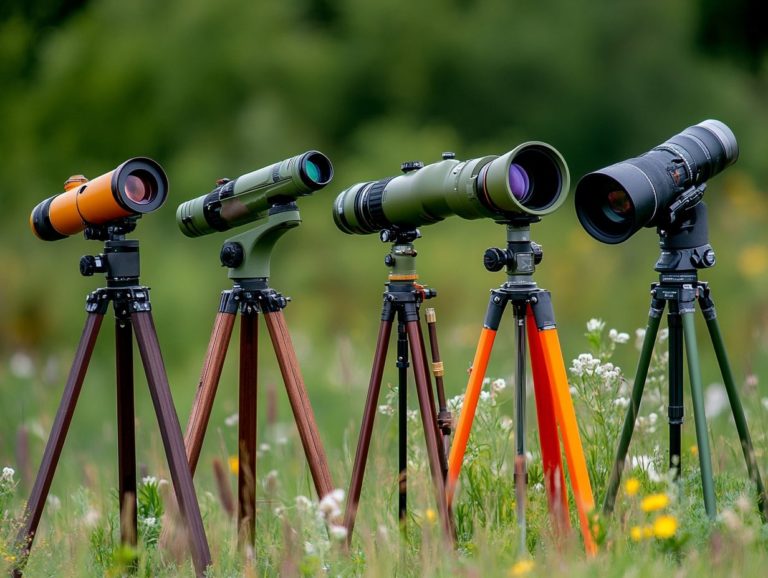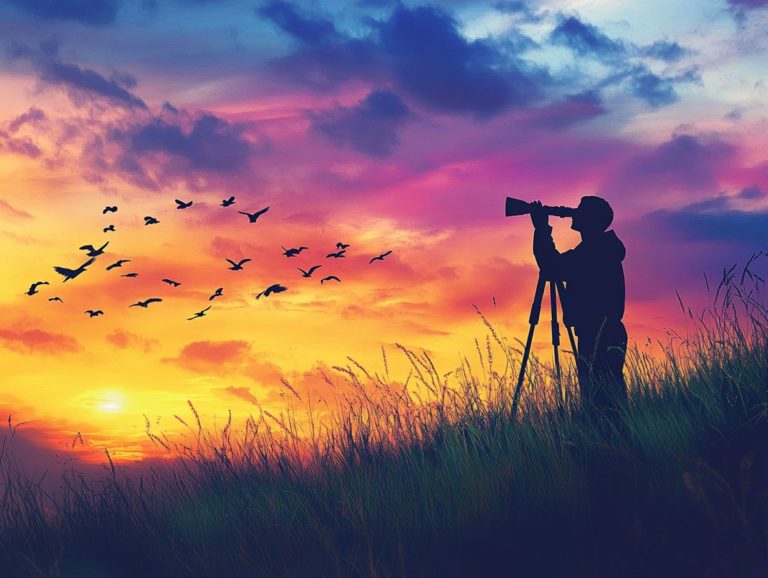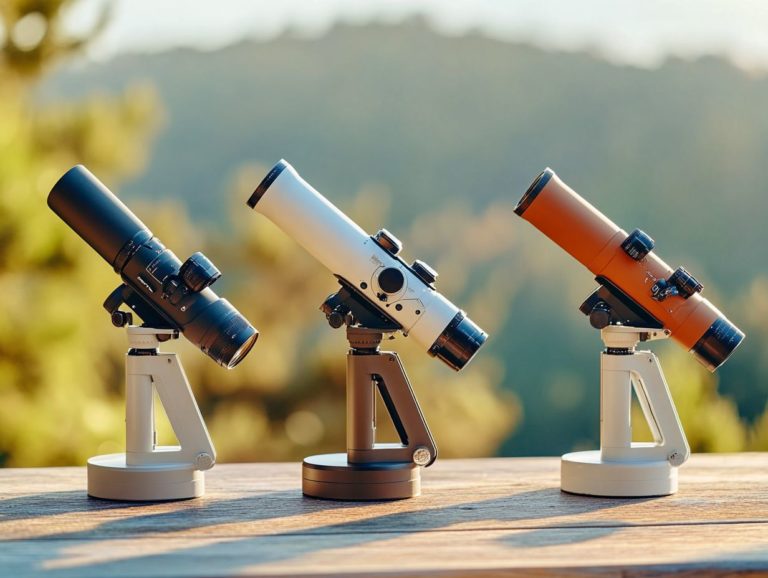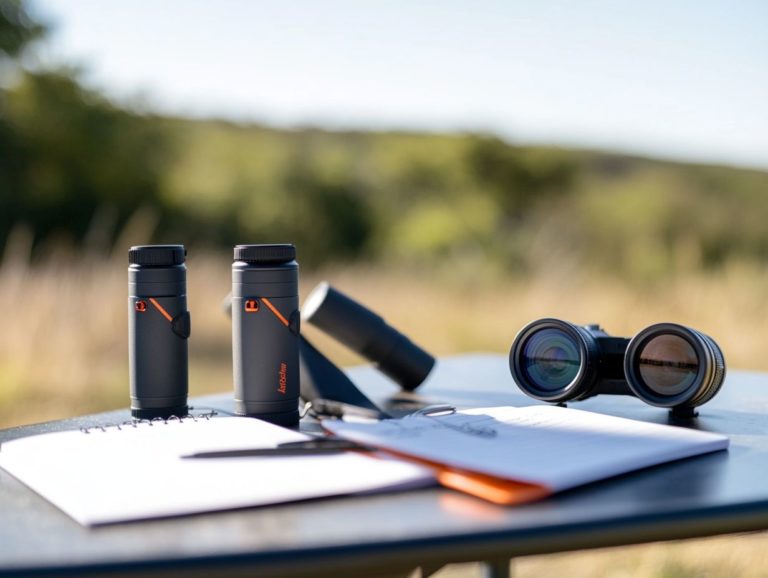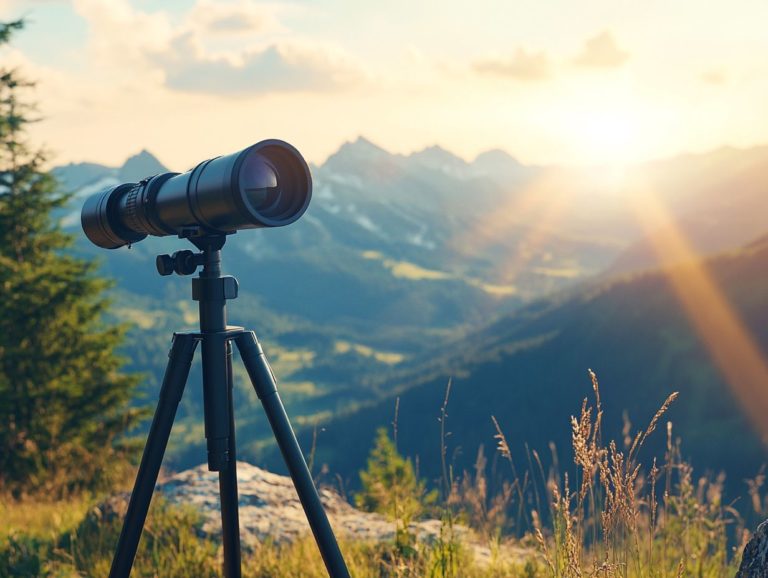How to Use a Smartphone with Your Spotting Scope
Combining your smartphone with a spotting scope can truly improve your outdoor photos, enabling you to capture breathtaking details of wildlife and landscapes.
This guide will assist you in selecting the perfect equipment, including compatible scopes and adapters, while also fine-tuning your camera settings for the best results.
Within these pages, you ll uncover invaluable tips for capturing stunning photos and videos, along with expert advice on sharing and editing your media.
You will discover a variety of accessories that can enhance your experience. Get excited to master digiscoping and capture amazing outdoor moments!
Contents
- Key Takeaways:
- Why Use a Smartphone with a Spotting Scope?
- Choosing the Right Equipment
- Setting Up Your Smartphone and Spotting Scope
- Tips for Taking Photos and Videos
- Sharing and Editing Your Media
- Additional Accessories and Techniques
- Frequently Asked Questions
- What is a spotting scope?
- Why would I want to use my smartphone with my spotting scope?
- How do I connect my smartphone to my spotting scope?
- Can I use any smartphone with my spotting scope?
- Are there any special features or settings I should use on my smartphone when using it with my spotting scope?
- Do I need to have a lot of technical knowledge to use my smartphone with my spotting scope?
Key Takeaways:
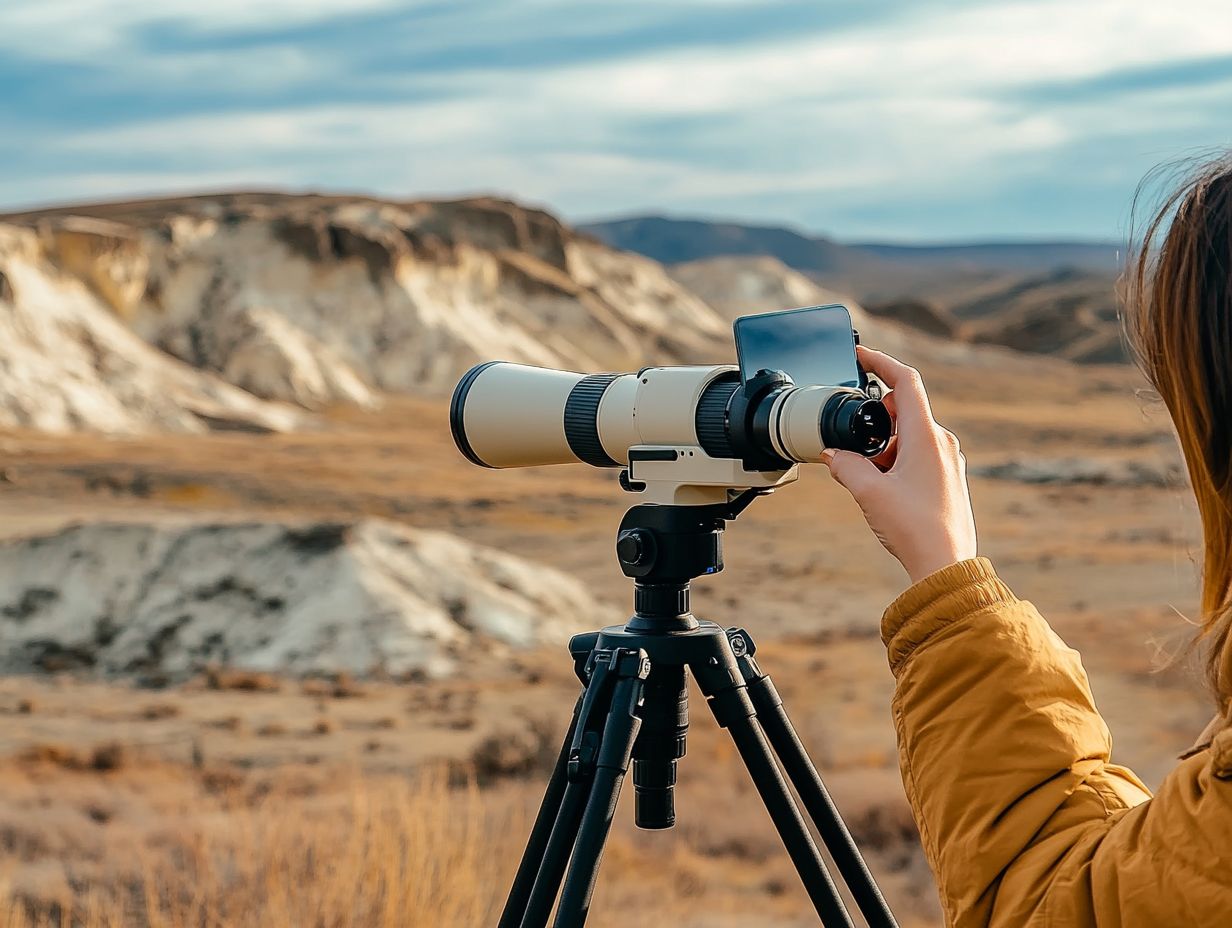
- Enhance your spotting scope experience by using a smartphone for photos and videos.
- Choose the right spotting scope and adapter for your smartphone.
- Adjust settings and explore additional accessories for optimal media quality.
Why Use a Smartphone with a Spotting Scope?
Using a smartphone with a spotting scope elegantly marries convenience with cutting-edge technology, creating a seamless experience for wildlife observation, photography, and even digiscoping. Digiscoping refers to taking pictures through a spotting scope using a smartphone or camera.
This powerful combination not only enhances the quality of the images you capture but also simplifies the task of focusing on distant subjects, whether it’s the Moon or Jupiter.
The versatility of smartphones makes them perfectly suited for digiscoping, allowing you to harness the impressive capabilities of their high-resolution cameras alongside the magnification prowess of spotting scopes.
The result? Breathtaking visuals that truly capture the wonders of the natural world.
Choosing the Right Equipment
Choosing the right equipment is crucial for unlocking the full potential of your smartphone photography, especially when paired with a spotting scope, telescope, or DSLR.
Considerations like compatibility, optical quality, and the specific smartphone adapter you select can profoundly influence the success of your wildlife observation and digiscoping experiences, especially when utilizing various zoom techniques.
Compatible Spotting Scopes and Adapters
When selecting a smartphone adapter for your spotting scope, compatibility is key. You want to ensure a secure fit and optimal performance, especially with trusted brands like Celestron, Bresser, and Orion. These adapters allow you to attach your smartphone effortlessly, providing a seamless experience while you capture amazing images of wildlife and celestial wonders.
Take the Celestron NexYZ adapter, for example. It s celebrated for its versatility and user-friendly design, offering sturdy support for a wide array of smartphone models. On the other hand, the Bresser smartphone adapter boasts a unique design that facilitates quick adjustments, perfect for those fleeting moments in nature.
By pairing the right spotting scope, such as the Orion Scenix, with an appropriate smartphone adapter, you elevate your photography experience. This combination enables you to capture high-quality images directly from your device. Not only does this synergy simplify the process, but it also unlocks new creative possibilities for both novice and experienced photographers alike.
Smartphone Camera Settings
Optimizing your smartphone camera settings is crucial for achieving high-quality photography when using a spotting scope, especially during wildlife and celestial observations. By fine-tuning settings such as focus, exposure, and digital zoom, you can enhance the quality of your images, resulting in sharper, more vibrant visuals.
Embrace continuous autofocus and tweak the exposure compensation to capture those fleeting moments when wildlife is on the move. Don t miss the shot! Use a higher ISO setting in low-light conditions to ensure that your subjects remain clear, free from excessive blur.
Saving your images in RAW format, a file type that captures all image data for better editing, grants you invaluable flexibility during post-processing. Popular editing software like Adobe Photoshop and Lightroom can elevate your final images, enabling you to adjust exposure, contrast, and color correction to truly showcase the beauty of nature.
Setting Up Your Smartphone and Spotting Scope
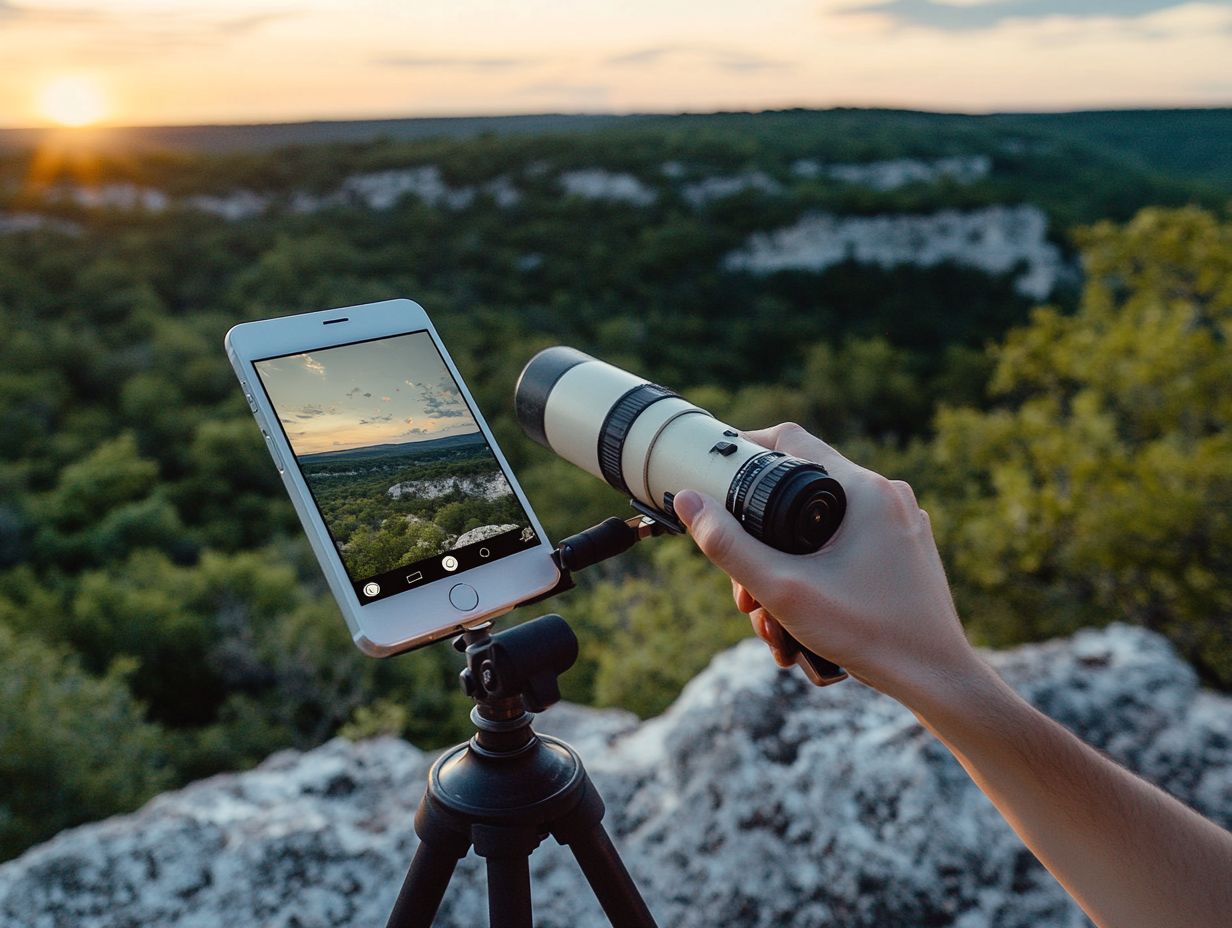
Setting up your smartphone and spotting scope with precision is essential for achieving remarkable results in wildlife photography and observation. For detailed instructions, refer to the step-by-step guide on securely attaching the smartphone adapter to the spotting scope to ensure stability and proper alignment.
Once you have that connection, take the time to adjust the tripod and manually focus until you achieve a crystal-clear view of your chosen subject, whether it s a distant bird or a celestial marvel like the Moon.
Attaching the Adapter
Attaching the smartphone adapter to your spotting scope is a straightforward task that requires careful alignment to ensure both stability and usability. By following specific guidelines for securing the adapter, you can improve your photography experience and capture stunning wildlife images.
-
Start by ensuring that both the scope and adapter are clean and free from dust or debris. Any particles can disrupt the connection and lead to shaky images.
-
Position the adapter over the eyepiece of the scope, ensuring it fits snugly. Gradually tighten the securing screws, but be careful not to tighten them too much; excessive pressure can throw your alignment off.
One common issue is the eyepiece not fitting securely, which can lead to image shake. In such cases, adding rubber or foam padding can significantly improve grip and provide extra stability. Check your smartphone s alignment through the adapter to confirm that the camera lens aligns perfectly with the optical path of the scope. You may need to make slight adjustments to minimize shake and enhance clarity.
Adjusting for Optimal Viewing
For optimal viewing and photography through a spotting scope, it’s crucial to adjust your setup to capture stunning wildlife images. Fine-tuning the focus and adjusting the eyepiece ensures your smartphone is perfectly positioned for a clear field of view.
Adjusting the focus unlocks stunning images! Experiment with different focus techniques to sharpen details and reduce blurriness. Don t overlook the importance of adjusting the eyepiece for comfort and clarity; doing so can greatly enhance your enjoyment of the view.
Properly aligning your smartphone is also key; even the slightest shift can lead to a missed opportunity. Remember that patience and consistent practice are essential for mastering these adjustments. With time, you ll achieve sharper images and a deeper appreciation of the natural world around you.
Tips for Taking Photos and Videos
Capturing breathtaking photos and videos with your smartphone and a spotting scope requires a mix of technique, zoom capabilities, and environmental awareness, especially regarding lighting.
By embracing a few practical tips, you can significantly improve the quality of your wildlife photography. Ensure your images are not only sharp but also vibrantly captivating with effective shooting techniques.
Lighting and Focus
Understanding how to manage lighting and focus is essential for achieving stunning results in smartphone photography, particularly when capturing wildlife through a spotting scope. Adequate lighting can dramatically improve your image quality, while precise focus ensures that your subjects are sharp and well-defined.
By mastering these elements, you can create dynamic compositions that showcase the beauty and behavior of wildlife. Adjusting exposure settings allows you to adapt to various conditions, whether you’re facing the bright midday sun or the gentle light of dawn and dusk.
For example, increasing the ISO which controls your camera’s sensitivity to light can brighten images in low-light environments. Meanwhile, a faster shutter speed determines how long the camera’s sensor is exposed to light, helping you freeze action on a sunny day, making it easier to capture stunning wildlife images.
Employing a wide aperture helps you achieve that coveted shallow depth of field, making your subject pop against a beautifully blurred background. Patience and keen observation are your allies; they enable you to anticipate movements and wait for that perfect moment, significantly enhancing the overall quality of your images.
Using Zoom and Other Features
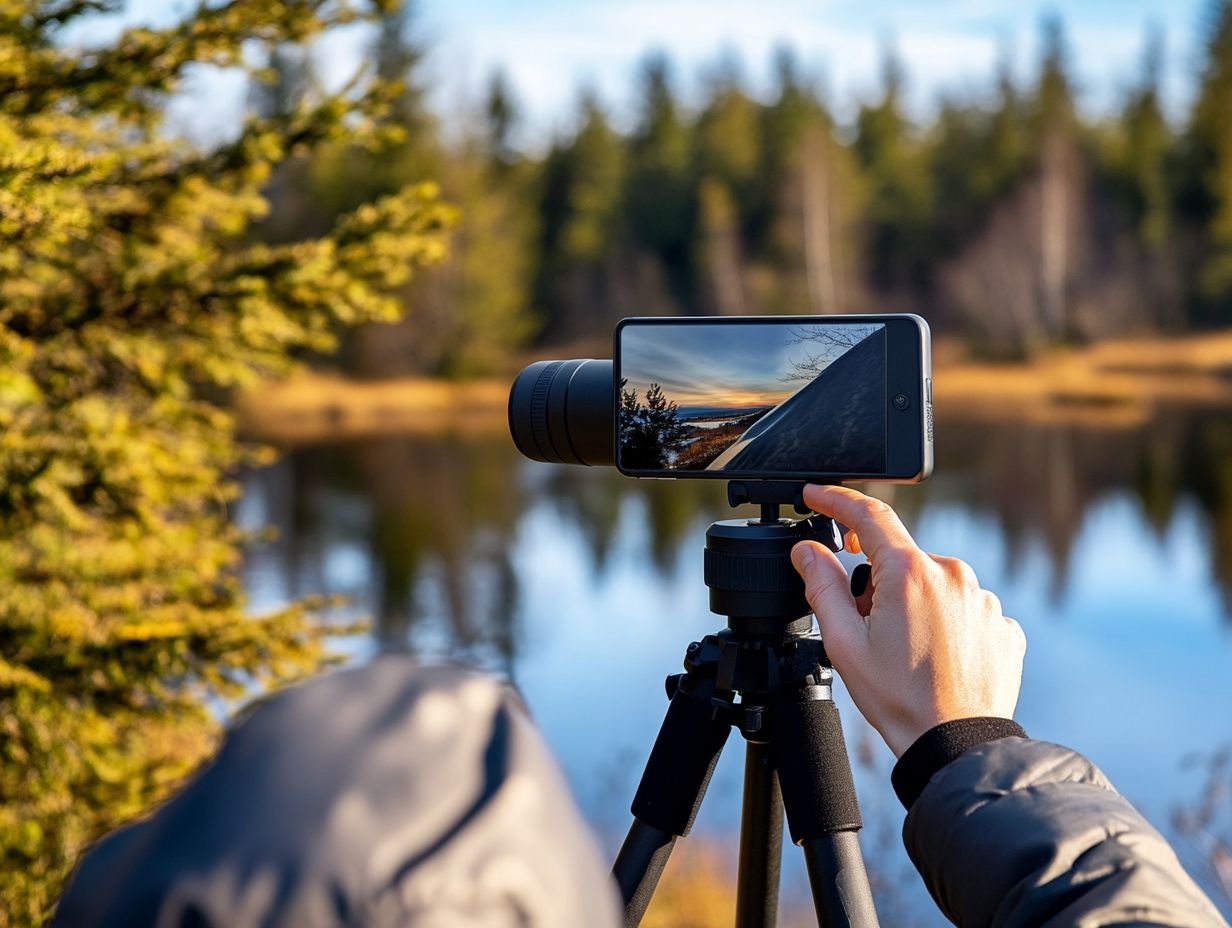
Using your smartphone s zoom features can greatly enhance your wildlife photography. This allows you to capture details that could easily be missed.
It s important to understand the difference between optical and digital zoom for the best image quality.
Optical zoom uses the camera’s lenses to make subjects look closer, producing clearer images with minimal pixelation. This method preserves resolution. In contrast, digital zoom crops and enlarges images, often resulting in a decline in quality.
Combining these zoom functions with features like stabilization which helps reduce blurriness from hand movements and burst mode, enabling you to capture multiple frames quickly, can significantly improve your photography results, even when using digital methods.
Mastering these tools helps you strike the perfect balance between convenience and quality, ensuring every detail is captured in stunning clarity.
Sharing and Editing Your Media
Once you’ve captured breathtaking photos and videos with your smartphone and spotting scope, it s time to share and edit your media to showcase your photography skills.
With powerful editing tools like Adobe Photoshop and Lightroom, you can refine your images to perfection before sharing them on social media platforms.
Social Media and Editing Apps
Social media has become a critical platform for sharing your wildlife photography. It s essential to leverage editing apps that enhance the quality of your images before posting. Apps like Adobe Photoshop and Lightroom allow you to elevate your photos into captivating visuals that attract audiences on platforms like Instagram and Facebook.
For wildlife photographers, showcasing your work on platforms such as Twitter and Pinterest can significantly increase your visibility. Each platform has its own audience and specific image dimensions, so understanding these details can improve your posts.
Crafting engaging captions can ignite conversations. Using hashtags like #WildlifePhotography can expand your reach. Don t overlook the timing of your posts; sharing during peak hours can lead to greater audience engagement.
For editing, user-friendly apps like Snapseed and VSCO enhance colors and details, allowing you to present your subjects in the most appealing light.
Additional Accessories and Techniques
Exploring additional accessories and techniques can significantly improve your smartphone photography efficiency and results when using a spotting scope or telescope.
Using tools like tripods and remote shutter releases enhances stability, allowing you to capture images that are sharp and beautifully composed, especially when using a spotting scope or telescope.
Remote Shutter Release and Tripods
Incorporating a remote shutter release and a sturdy tripod into your smartphone photography setup can significantly enhance the clarity and focus of your images. These accessories reduce camera shake and provide precise control, especially when capturing wildlife or celestial subjects.
Using these tools not only stabilizes images but also opens creative possibilities for longer exposure shots without the worry of blurriness. When selecting a tripod, look for adjustable height, compactness for easy transport, and a robust build that can withstand various environmental conditions.
For the remote shutter release, ensure your smartphone settings are optimized. Experimenting with burst mode for action shots or the timer function for group photos can greatly improve your photography experience, helping you capture stunning moments effortlessly.
Digiscoping and Digibinning
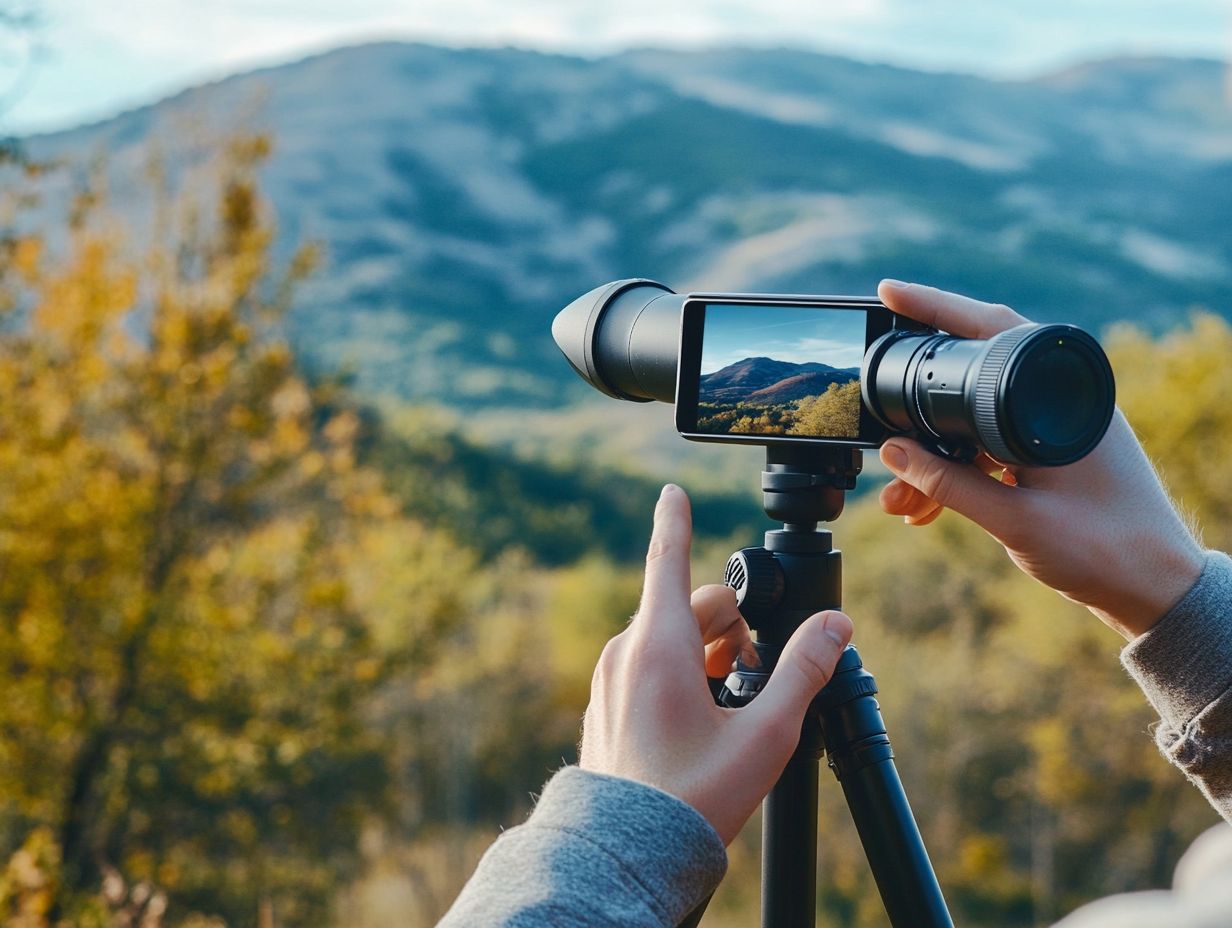
Digiscoping and digibinning are innovative techniques in wildlife photography that let you use your smartphone with a spotting scope or telescope. These methods help you capture detailed images of distant subjects, enhancing your ability to observe and document wildlife in their natural habitats.
Using a spotting scope or telescope allows you to achieve impressive zoom that traditional cameras often struggle to match. This capability provides crisp, close-up shots of animals, fostering a deeper connection with your subjects.
The combination of smartphones and optical instruments offers a lightweight, portable solution for capturing high-quality images. Whether you’re using a spotting scope or advanced telescopes, this method is accessible for both amateurs and seasoned professionals.
If you’re excited to get started, consider investing in a reliable smartphone adapter from brands like Bresser, Celestron, or Orion. Remember, patience is key! Wildlife photography often demands time and keen observation to yield the most rewarding results.
Frequently Asked Questions
What is a spotting scope?
A spotting scope is like a telescope but designed for nature viewing, commonly used for birdwatching, hunting, and other outdoor activities.
Why would I want to use my smartphone with my spotting scope?
Using your smartphone with a spotting scope allows you to take photos and videos of the magnified view, making it easier to capture and share your observations. For tips on this technique, check out how to use a spotting scope with a camera.
How do I connect my smartphone to my spotting scope?
The way to connect your smartphone may vary by model, but typically involves using an adapter to attach your phone to the eyepiece of the scope.
Can I use any smartphone with my spotting scope?
Most spotting scope adapters fit a variety of smartphone models, but it’s best to check compatibility with your specific phone before purchasing.
Are there any special features or settings I should use on my smartphone when using it with my spotting scope?
Some smartphones have camera modes or apps designed for capturing photos and videos through a spotting scope. It’s worth exploring these options for the best results.
Do I need to have a lot of technical knowledge to use my smartphone with my spotting scope?
While some experience might help, most spotting scope adapters and instructions are user-friendly and easy to use for all levels of expertise.
Ready to dive into wildlife photography? Grab your spotting scope and smartphone today!


